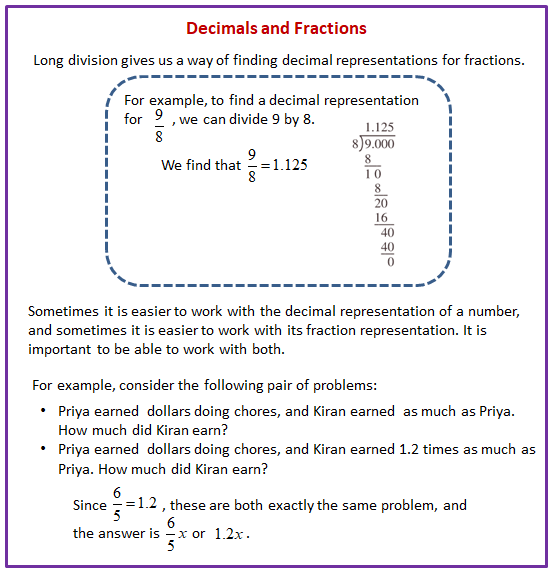Illustrative Mathematics Grade 7, Unit 4, Lesson 5: Say It with Decimals
Learning Targets:
- I can use the distributive property to rewrite an equation like x + 0.5x = 1.5x.
- I can write fractions as decimals.
- I understand that “half as much again” and “multiply by 1.5” mean the same thing.
Related Pages
Illustrative Math
Grade 7
Lesson 5: Say It with Decimals
Let’s use decimals to describe increases and decreases.
Illustrative Math Unit 7.4, Lesson 5 (printable worksheets)
Lesson 5 Summary
The following diagram shows how to write fractions as decimals.

When we work with percentages in later lessons, the decimal representation will come in especially handy.
Lesson 5.1 Notice and Wonder: Fractions to Decimals
A calculator gives the following decimal representations for some unit fractions:
What do you notice? What do you wonder?
Lesson 5.2 Repeating Decimals
- Use long division to express each fraction as a decimal.
- What is similar about your answers to the previous question? What is different?
- Use the decimal representations to decide which of these fractions has the greatest value. Explain your reasoning.
Are you ready for more?
One common approximation for π is 22/7. Express this fraction as a decimal. How does this approximation compare to 3.14?
-
Show Answer
22/7 = 3.14285714286 …
π = 3.14159265359 …
22/7 is closer to π then 3.14
Lesson 5.3 More and Less with Decimals
- Match each diagram with a description and an equation.
- Draw a diagram for one of the unmatched equations.
Lesson 5.4 Card Sort: More Representations
Your teacher will give you a set of cards that have proportional relationships represented 3 different ways: as descriptions, equations, and tables. Mix up the cards and place them all face-up.
- Take turns with a partner to match a description with an equation and a table.
a. For each match you find, explain to your partner how you know it’s a match.
b. For each match your partner finds, listen carefully to their explanation, and if you disagree, explain your thinking. - When you agree on all of the matches, check your answers with the answer key. If there are any errors, discuss why and revise your matches.
Glossary Terms
repeating decimal
A repeating decimal has digits that keep going in the same pattern over and over. The repeating digits are marked with a line above them.
Lesson 5 Practice Problems
- a. Match each diagram with a description and an equation.
b. Draw a diagram for one of the unmatched equations. - At the beginning of the month, there were 80 ounces of peanut butter in the pantry. Since then, the family ate 0.3 of the peanut butter. How many ounces of peanut butter are in the pantry now?
- a. On a hot day, a football team drank an entire 50-gallon cooler of water and half as much again. How much water did they drink?
b. Jada has 12 library books checked out and Han has 1/3 less than that. How many books does Han have checked out? - If x represents a positive number, select all expressions whose value is greater than x.
- A person’s resting heart rate is typically between 60 and 100 beats per minute. Noah looks at his watch, and counts 8 heartbeats in 10 seconds.
a. Is his heart rate typical? Explain how you know.
b. Write an equation for h, the number of times Noah’s heart beats (at this rate) in m minutes.
The Open Up Resources math curriculum is free to download from the Open Up Resources website and is also available from Illustrative Mathematics.
Try out our new and fun Fraction Concoction Game.
Add and subtract fractions to make exciting fraction concoctions following a recipe. There are four levels of difficulty: Easy, medium, hard and insane. Practice the basics of fraction addition and subtraction or challenge yourself with the insane level.

We welcome your feedback, comments and questions about this site or page. Please submit your feedback or enquiries via our Feedback page.